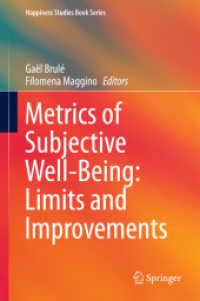- ホーム
- > 洋書
- > 英文書
- > Psychology
Full Description
Offenders convicted of violent crimes accounted for almost 15,000 (7.5%) of the federal inmate population in recent reports; and, despite the public's perception that the overall crime rate is down, there are indications that rates of violent crime may actually be increasing in certain geographic areas and populations. In response, forensic psychologists are increasingly being called upon to understand the causes of violence, predict violent behavior and the likelihood or recidivism, develop treatment programs, and even assist law enforcement in solving crimes. The assessment of violence is an ever-evolving field of study and the need for updated analysis of personality constructs, etiological links, corollary elements, and tools for violence prediction are of primary import.
Violent Offenders addresses the numerous challenges and issues facing individuals working with this population and provides broad coverage regarding specific groups of violent perpetrators. It looks at a wide-range of topics and offending populations including violent children and adolescents, intimate partner violence, terrorism, sexually based crimes, gang violence, institutional violence, and violence perpetrated by police officers. Skillfully edited by Christina Pietz, a forensic psychologist, and Curtis Mattson, a clinical psychologist, this volume offers insight into current psychological theories of violence and addresses the links, both evident and assumed, between psychological disorders and violence. Chapters are authored by leaders in their fields and cover topics such as the psychiatric treatment of violent behavior, assessment and prediction of risk for future dangerousness, special considerations for ethical conduct, research considerations, and the etiological associations of violence with neurophysiology, substance abuse, and environment. Violent Offenders will benefit clinicians and professionals working in correctional and forensic fields and is appropriate for use in clinical and counseling graduate programs that offer specialized training in correctional and/or forensic psychology and for courses in deviant behavior and setting-specific assessment.
Contents
About the Editors ; Contributors ; Section I. Overview and Constructs of Violence ; 1. Psychological Perspectives of Violence ; Melanie Schettler ; 2. Antisocial Behavior among Children in Poverty: Understanding Environmental Effects in Daily Life ; Michael A. Russell and Candice L. Odgers ; 3. Substance Abuse and Violence ; Curtis A. Mattson and Christina A. Pietz ; 4. Major Mental Disorders and Violence ; Laura S. Guy and Kevin S. Douglas ; 5. Aggressive Externalizing Disorders: Conduct Disorder, Antisocial Personality Disorder, and Psychopathy ; Laura E. Drislane, Noah C. Venables, and Christopher J. Patrick ; Section II. Special Offender Populations ; 6. Juvenile Homicide: Trends, Correlates, Causal Factors, and Outcomes ; Kathleen M. Heide ; 7. Physically and Sexually Violent Females ; Geoffrey R. McKee and R. Gregg Dwyer ; 8. Men Who Kill ; Bethany K. Walters and Eric W. Hickey ; 9. Psychological Factors in Intimate Partner Violence ; Donald Dutton and Christie Tetreault ; 10. Perpetrators of Sexual Violence: Demographics, Assessments, Interventions ; Alix M. McLearen, Ivonne E. Bazerman, and Katherine Bracken-Minor ; 11. Under the Color of Authority: Police Officers as Violent Offenders ; David M. Corey and Casey O. Stewart ; 12. Institutional Violence Risk: Theory, Assessment, and Management ; Daniel J. Neller and Michael J. Vitacco ; 13. Youth Gangs: An Overview of Key Findings and Directions for the Future ; Terrance J. Taylor and J. Michael Vecchio ; 14. Understanding Terrorists ; Randy Borum ; Section III. Evaluative Approach and Special Considerations ; 15. Legal, Clinical and Scientific Foundations of Violence Risk Assessment ; David F. Mrad and Daniel J. Neller ; 16. Use of Assessment Measures for the Evaluation of Future Risk ; Chad A. Brinkley ; 17. The Structured Professional Judgment Approach to Violence Risk Assessment and Management: Why it is Useful, How to Use it, and its Empirical Support ; Kevin S. Douglas and Henrik Belfrage ; 18. Assessing Facets of Personality and Psychopathology in Violent Offenders ; Dustin B. Wygant, Kathryn C. Applegate, and Tina D. Wall ; 19. Assessing malingering in violent offenders ; Holly A. Miller ; 20. Assessment of Neurophysiological and Neuropsychological Bases for Violence ; Rachel Fazio and Robert L. Denney ; 21. Violence: Psychiatric Assessment and Intervention ; Charles Scott, Philip J. Resnick, and William Newman ; 22. Ethical Considerations and Professional Posture ; Kimberly Larson, Robert Kinscherff, and Stacey Goldstein-Dwyer ; 23. Conducting Research with Special Populations ; Gianni Pirelli and Patricia A. Zapf ; Index








